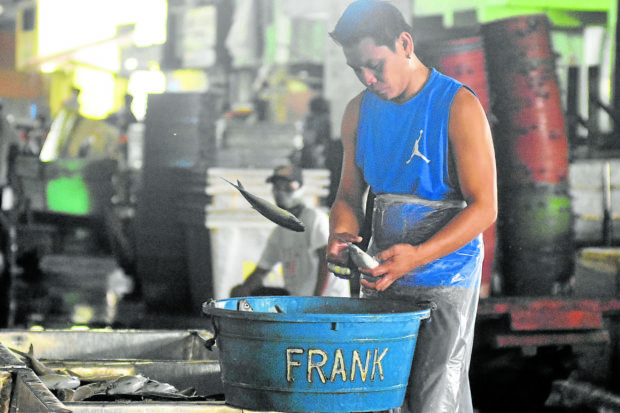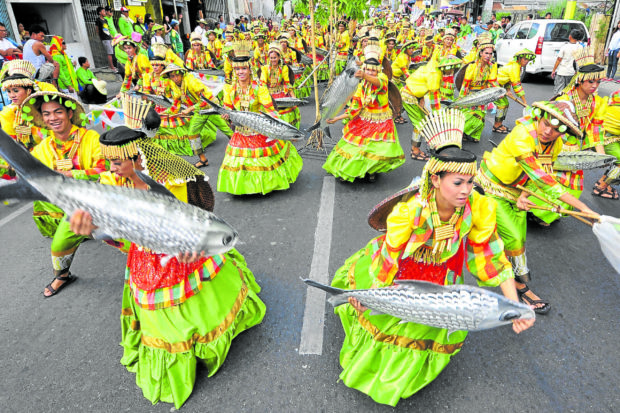Dagupan bangus industry thrives amid pandemic

BUSINESS AS USUAL It’s business as usual at Magsaysay Fish Market in Dagupan City, where trading of “bangus” (milkfish), the top product of Dagupan and the rest of Pangasinan, never stops despite quarantine restrictions due to the COVID-19 pandemic.—PHOTO BY WILLIE LOMIBAO
DAGUPAN CITY, Pangasinan, Philippines — For years, fish trader Melecio Melendez, 35, would always look forward to the month of April when the city would stage the annual Bangus Festival.
His ordinary day at the “bangus” consignacion (milkfish wholesale market) along Pantal River here involves overseeing workers unloading blocks of ice from trucks, pushing carts filled with milkfish, and hauling stocks to his vehicle.
So the monthlong celebration of the festival had always provided him and his fellow traders the much-needed relief from their grueling work.
“It was a fun time for all of us working at the consignacion. We especially enjoyed the bangus rodeo,” Melendez told the Inquirer in a recent interview.
Fishpond and fish cage owners and their workers, vendors and processors would compete against each other in the festival’s bangus rodeo to be recognized as the best in classifying the fish by its size. Bangus are classified into small, medium and large batches, according to their weight. Classifiers use their fingers and palms in sorting the bangus instead of a weighing scale.
Article continues after this advertisementMelendez would always beat all other contenders to emerge as the champion in that event, locally known as “panagsaysay.”
Article continues after this advertisementThis made him a celebrity of sorts during the contest since he had been unbeatable for 14 years straight. Melendez would take home P5,000 in cash, which he used to treat the consignacion workers to celebrate the feat.
In 2015, organizers asked him to stop joining the rodeo “to give others a chance.”
From being a “managsaysay” since he was 14 years old, Melendez now operates his own consignacion stall that provides him a neat sum daily.
‘Passion’
Melendez may no longer need the prize, but he still misses joining the rodeo, which he describes as his “passion.”
He now has more reasons to yearn for the contest since it may take time for the city to again stage the festival, which has been canceled for the second time this year due to the coronavirus pandemic.
What would have been the festival’s 21st edition this year had been shelved to avoid large gatherings, said Mayor Brian Lim.
In place of the festival that would have culminated in the tourist-drawing “Kalutan ed Dalan” (bangus grilling street party) on April 30, the city government chose to seed the Dawel River, one of the seven rivers that crisscross the city, with bangus fingerlings.
About, 60,000 bangus fry were also distributed to selected fishermen from the city’s island villages.
While there were no scheduled activities on April 30, Malacañang had declared the day a holiday in Dagupan.

SUMMER EVENT Representatives from a village in Dagupan City perform during the 2015 staging of the “Gilon-Gilon ed Baley” street dancing competition, one of the highlights of the Bangus Festival. The pandemic has again forced city officials to cancel this summer event that draws crowds to Dagupan. —PHOTO BY WILLIE LOMIBAO
Economic backbone
But Dagupan’s bangus industry, on which the festival was based, remains vibrant and thriving. It continues to be the city’s economic backbone, officials said.
At the city’s public market, the prices of bangus range from P120 to P125 a kilo.
Transporting the fish to Metro Manila and other provinces even at the height of the hard lockdown last year was made easy by the Bureau of Fisheries and Aquatic Resources (BFAR) in the Ilocos region.
The BFAR issues food passes to traders, preventing the cultured fish in ponds and cages from getting wasted.
Dagupan still has 910 hectares of fishponds devoted to bangus with a total production of 2.5 tons of the fish in 2020.
Local data showed that the harvest had been supplemented by fish cages that produced 3.2 tons that year. There are 1,465 operators of fishponds and cages in the city rivers.
But the city’s production is minuscule compared to the total production of Pangasinan province, the top bangus producer in the country.
But bangus grown in the city has earned the reputation of being the “best tasting,” leading the city council to pass a resolution accrediting local growers to avoid varieties passed off by unscrupulous traders as grown in Dagupan.
In 2019, Pangasinan produced 109,893.50 metric tons of milkfish, or 27 percent of the country’s total production of 409,906.56 MT.
Dagupan’s consignacion does not only sell bangus harvested from the city’s ponds and cages, but also those coming from western Pangasinan towns and, in limited volume, from Bulacan province.
“You will know if the bangus come from Dagupan or nearby Binmaley if they are brought in by boats. If by trucks, they are harvested from aquaculture areas in western towns like Sual, Bolinao and Anda,” bangus stall owner Raymund Torio said.
The city agriculture office is still collating the volume of bangus that goes through the market daily, said City Administrator Vladimir Mata, acting Dagupan agriculture officer.
As for the Bulacan bangus, only 1,800 kilos are allowed to be brought in weekly, and vendors must declare where their harvests came from.
“‘Viajeros’ (traders) however, already know how to determine the source of the fish just by looking at the physical appearance,” Melendez said.
Lim said the oversupply of production in other provinces forced traders to bring milkfish to the city and pass them off as Dagupan or Pangasinan bangus.
Premium quality
“We know that there is a certain premium to Dagupan and Pangasinan bangus because [of their] quality and [they] are delicious,” Lim said.
He added: “While we want to protect our industry, we can’t really stop other provinces to bring their produce here because of free trade. This is why we put safeguards to protect our industry.”
The threat of “alien bangus,” the cancellation of the Bangus Festival and the pandemic notwithstanding, the industry has endured and remained profitable, Lim said.
Among the reasons for the industry’s endurance, he said, is the “mild inflation” brought on by the pandemic that raised the prices of basic commodities, especially food.
Local consumers prefer bangus over other fish varieties because there is enough supply to meet the consumers’ demand, Lim said.
“For example, if the demand today is 10 tons, it is easy to get 10 tons because there is a network of bangus growers in Pangasinan towns like Binmaley, Lingayen, Sual, Anda and Bolinao,” he said.
Lim said the African swine fever that battered the hog industry in Luzon and severely cut down the supply of pork also made consumers turn to bangus.
“Increase in prices of chicken [also] led consumers to look for alternative sources of protein, and bangus is available and a viable protein source [to replace pork and chicken],” Lim said.
The industry has also proven to be resilient, or not much subject to microbiological factors.
“Bangus is not susceptible to diseases and pests, although admittedly there are incidents of fish kill because of changing weather conditions and of water quality,” Lim said.
But overall, local fishers have grown to learn how to manage and minimize the impact of these problems, he added.